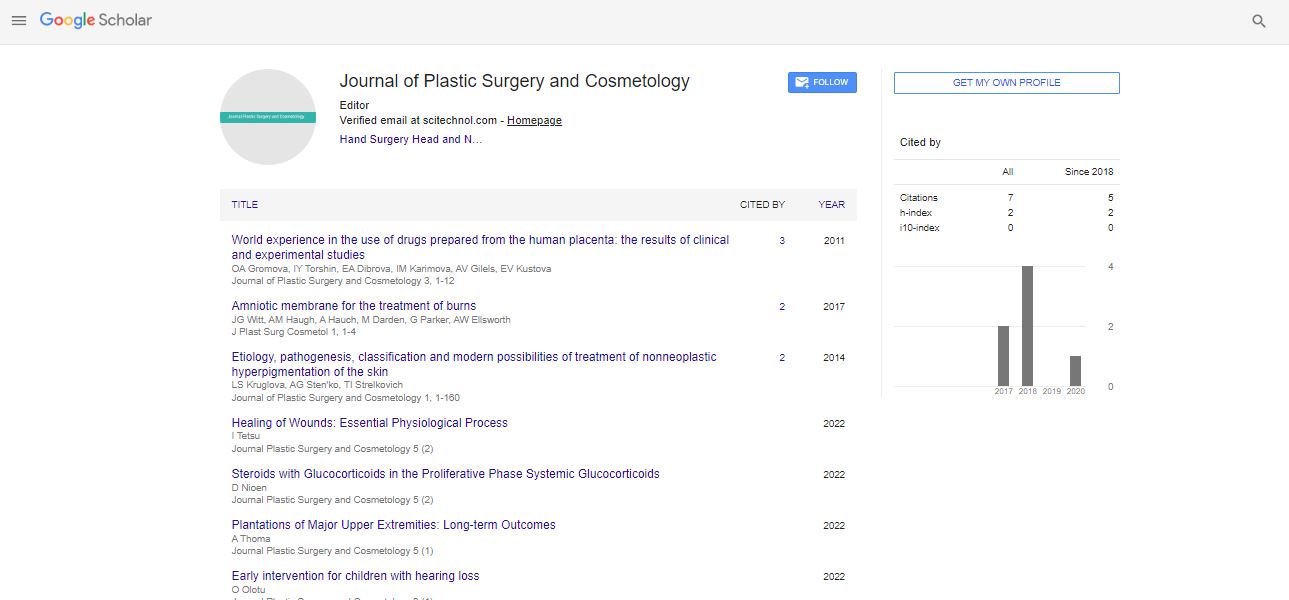Opinion Article, J Pls Sur Cos Vol: 12 Issue: 1
An Overview on Skin Surgery Benefits and Risk Factors
Orjan Friberg*
Department of Cardiothoracic and Vascular Surgery, Orebro University Hospital, Orebro, Sweden
*Corresponding Author: Orjan Friberg
Department of Cardiothoracic and Vascular
Surgery, Orebro University Hospital, Orebro, Sweden
E-mail: fribergorjan@edu.se
Received date: 03-Feb-2023, Manuscript No. JPSC-23-95388;
Editor assigned date: 06-Feb-2023, PreQC No. JPSC-23-95388 (PQ);
Reviewed date: 20-Feb-2023, QC No JPSC-23-95388;
Revised date: 27-Feb-2023, Manuscript No. JPSC-23-95388 (R);
Published date: 07-Mar-2023 DOI: 10.4172/JPSC.100043.
Citation: Friberg O (2023) An Overview on Skin Surgery: Benefits and Risk Factors. J Pls Sur Cos 12:1.
Keywords: Aesthetic Surgery, Breast Augmentation, Breast Reconstruction
Description
Skin surgery, also known as dermatologic surgery, is a specialized field of medicine that deals with the diagnosis and treatment of various skin conditions. The procedures involved in skin surgery are aimed at correcting or improving various skin problems, including skin cancer, benign tumors, moles, scars, and birthmarks.
Different types of skin surgery
Excision surgery: This type of surgery involves the removal of skin lesions or tumors by cutting them out. It is often used to remove cancerous or pre-cancerous growths, as well as benign tumors and cysts.
Mohs surgery: This is a specialized type of skin surgery that is used to remove skin cancer. It involves the removal of the cancerous tissue layer by layer until all the cancer cells are removed.
Cryosurgery: This type of skin surgery involves the use of liquid nitrogen to freeze and destroy abnormal cells, such as warts or precancerous lesions.
Laser surgery: This type of surgery uses a high-energy beam of light to remove or vaporize skin lesions. It is often used to treat birthmarks, scars, and other cosmetic skin problems.
Skin grafts: This type of surgery involves taking healthy skin from one part of the body and transplanting it to another area that has been damaged by injury, burn, or surgery.
Before undergoing skin surgery, it is important to have a thorough consultation with a qualified dermatologist or plastic surgeon. The doctor will assess the condition of skin and recommend the most appropriate surgical procedure based on the specific needs and medical history.
Skin surgery is generally performed under local anesthesia, which numbs the area being treated. In some cases, general anesthesia may be necessary, especially for larger surgical procedures.
The recovery time for skin surgery varies depending on the type and extent of the procedure. In general, patients can expect some swelling, bruising, and discomfort in the treated area, which should subside within a few days to a week. Most patients can return to work and normal activities within a week or two after surgery.
Like any surgical procedure, skin surgery does carry some risks, including bleeding, infection, scarring, and allergic reactions to anesthesia. However, these risks are generally low when the surgery is performed by a qualified and experienced surgeon.
In addition to treating specific skin conditions, skin surgery can also be used for cosmetic purposes, such as removing wrinkles, tightening sagging skin, and improving the appearance of scars and birthmarks. These procedures are often referred to as cosmetic dermatology and are typically performed by plastic surgeons or dermatologists who specialize in cosmetic procedures.
Some of the most common cosmetic skin surgery procedures
Facelift: This is a surgical procedure that lifts and tightens sagging skin on the face and neck. It can also be used to remove wrinkles and other signs of aging.
Blepharoplasty: This is a surgical procedure that removes excess skin and fat from the eyelids, giving the eyes a more youthful and refreshed appearance.
Rhinoplasty: This is a surgical procedure that reshapes the nose, improving its appearance and correcting functional problems such as breathing difficulties.
Liposuction: This is a surgical procedure that removes excess fat from specific areas of the body, such as the abdomen, thighs, and buttocks.
Breast augmentation: This is a surgical procedure that enhances the size and shape of the breasts using implants or fat transfer.
 Spanish
Spanish  Chinese
Chinese  Russian
Russian  German
German  French
French  Japanese
Japanese  Portuguese
Portuguese  Hindi
Hindi 